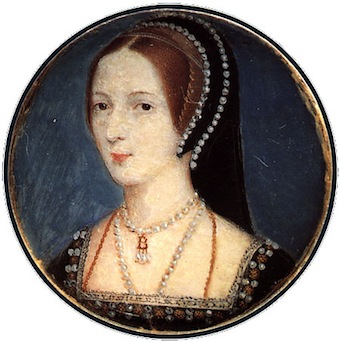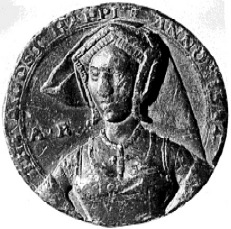I am delighted to welcome Barbara Parker Bell, author of ‘Inside the Wardrobe of Anne Boleyn‘, to On the Tudor Trail. Barbara has written an interesting guest post about an artefact the Victorians associated with Queen Anne Boleyn. Over to Barbara!
Anne Boleyn’s “tippet of ermine with marks of blood on it”
By Barbara Parker Bell
How wonderful would it be if an artefact belonging to Anne Boleyn was suddenly discovered? It is certainly a dream come true for anyone interested in Anne and the Tudor period. Such finds, however, are rare in our times, but they were quite often discovered during the Victorian period. The Victorians, as you’ve probably learned, were fascinated with the Tudors, especially with tragic queens such as Anne Boleyn, Katherine Howard and Jane Grey. Artefacts belonging to these executed queens were miraculously found and made their way to collections displayed in museums and galleries. In 1890, The New Gallery on Regent Street opened the ‘Exhibition of the Royal House of Tudor’. The New Gallery no longer exists, but you can still find a drawing of the Central Hall as it looked in 1888, two years before it was filled with the Tudor artefacts.
Illustrious personages of the era, mostly members of the nobility, submitted precious relics from the Tudor period. Portraits and miniatures, everyday items, coffers and chests, even locks of hair were displayed. Among them was a group of artefacts associated with Anne Boleyn. My attention was instantly caught by the “tippet of ermine worn by Queen Anne Boleyn at her execution, with marks of blood on it”, and in this article we will concentrate on this piece and attempt to establish its authenticity.
One of the eyewitnesses of Anne Boleyn’s execution recorded that she wore a “short mantle furred with ermines”, while the Victorians claimed that this piece was a “tippet”. A mantle was a sleeveless outer garment or ceremonial gown with a long train, usually trimmed with fur, though ermine was reserved for royalty. A tippet was a short shoulder cape, often quite close fitting, worn with a gown and usually made of fur. One example of a long mantle of cloth of gold furred with ermine survives in the coronation portrait of Elizabeth I, while a furred tippet, worn around the neck, survives in the miniature of Margaret Roper, painted about 1535.
The Victorians claimed that the “tippet” was stained with blood, but it seems highly unlikely since the eyewitness recorded that before Anne was beheaded, her short mantle was removed from her shoulders by one of her ladies-in-waiting. Another eyewitness recorded that the distressed female attendants who accompanied Anne at the scaffold “withdrew themselves some little space”, probably avoiding the Queen’s blood spurting on them, so it seems highly unlikely that any item held by the ladies, including the Queen’s short mantle trimmed with ermine, got stained with blood.
Another reason to question the authenticity of the tippet stained with blood allegedly worn by Anne Boleyn on her execution day is the fact that the Crown redeemed “such jewels and apparel as the late Queen had in the Tower” shortly after her death. All valuable items, such as her necklaces, headdresses and rings, probably formed a part of this collection. Ermine fur was very expensive, so it is reasonable to assume that Anne’s “short mantle furred with ermine” went straight back to the Great Wardrobe and was worn by Henry VIII’s subsequent wives.
While it would be exciting to claim the blood-stained tippet was a contemporary piece of clothing worn by Anne Boleyn, it is almost certainly necessary to dismiss it as a hoax. The only credible artefacts associated with Anne Boleyn displayed at the ‘Exhibition of the Royal House of Tudor’ included a letter written by Anne to Thomas Cromwell on 8 March 1534 with her signature “Anne the Quene [Queen]” and a medal struck in 1534. The rest are either false artefacts or items linked to Anne Boleyn through tradition rather than through solid historical record.
Sources:
New Gallery (London, England), ‘Exhibition of the Royal House of Tudor’
Letters and Papers, Foreign and Domestic, Henry VIII, Volume 10 – January-June 1536
Letters and Papers, Foreign and Domestic, Henry VIII, Volume 11 – July-December 1536



















Great article! Thanks!
Not entirely impossible. OK, the women moved away. Still could have been hit with some blood. After all, they moved her body afterward. So they’d have blood on themselves and thus could have, through contact with their hands or clothing, got blood on Anne’s belongings.